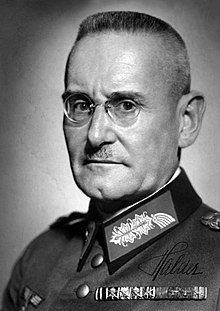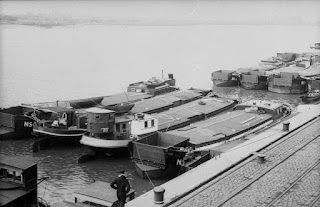When France collapsed in mid-June 1940 the German staff had not even considered, let alone planned, the invasion of Britain. No troops had received any training for seaborne landings and nothing had been done to procure the means to move armed forces across the Channel. Air superiority, let alone supremacy, would be a minimum requirement for any realistic German invasion plan. But this, too, never came near to being achieved. Nor was there any real political will to invade. But the episode remains one of the great myths of British history.
German miliary resources
German naval resources were sparse. Losses in the
Norway campaign had been significant - three cruisers and ten destroyers had
been sunk. In addition two heavy cruisers and one battleship had been severely
damaged and were laid up for repairs. So in July 1940 Kriegsmarine head Admiral
Raeder had only one heavy and two light cruisers, plus four destroyers, available. As celebrated Third Reich historian Richard Evans points out, “This
was a woefully inadequate force with which to attempt to win command of an
English Channel protected by five Royal Navy battleships, 11 cruisers and 30
destroyers, backed by another major naval force that could sail from Gibraltar
at a moment’s notice”. The French fleet, which might have provided extra
capacity for Raeder, had been largely destroyed by Britain at Mers-el-Kebir.
The German position was so poor that even had the RAF been decimated, the Royal Navy would almost certainly have beaten any German invasion attempt itself. Not only were there nowhere near enough ships to protect any large troop carrying force, the 2000 or so flat bottom barges the Germans had scraped together were mainly culled from Rhine river service. The effect of gathering together every commercial barge available was seriously to disrupt economic activity in Germany and the Low Countries. The vessels would be sitting ducks for RAF bombers and totally unsuitable for a Channel crossing in anything but the calmest weather. It has been demonstrated that the RN would not even have needed to fire a shot. The barges, if approached by British warships, would simply have been sunk in the wash.
Sandhurst war game modelling, much later on in the 1990s, showed just how hopeless were the prospects for a German seaborne attack. Whatever parameters were changed, including at an extreme, non-intervention by the RAF, it failed to produce a positive outcome. In short the result would have been a catastrophe.
German military views
Unsurprisingly perhaps, the German Navy was not at all enthusiastic about an invasion given its paucity of ships and usable landing craft. Playing for time it suggested it would be in a far better position to undertake such a venture in May 1941, the following year.
The Wehrmacht, too, was
unhappy at the prospect. It had just fought some major battles in France and
Belgium, and wanted time to re-group, replace or repair its equipment, and rest
its troops. Officers were also concerned that no training had been undertaken
and that the transport arrangements and plans to re-supply the invading forces
were shambolic or non-existent. Even had they secured a bridgehead there was no
proper plan to supply the troops involved. If the army was forced to fight, it
wanted to disperse its forces and attack in multiple locations along a 200 mile
front on England’s southern coast.
Kriegsmarine officers,
however, would have preferred to advance on a narrow front in a concentrated
thrust, to minimise their vulnerability to both naval and air attack. Chief of
Staff Halder protested “this would be like putting my men through a sausage
machine”. An argument between the two services developed.
Comparative air strength
Air force strength
between the sides was effectively at a rough parity of numbers. In mid-August
1940, at the start of the Battle of Britain, there were 1379 RAF fighter pilots
in a state of operational readiness. The comparable number of Luftwaffe pilots
was 870, though the RAF pilots were of course spread all over the country while
the Germans were concentrated along the Channel coast. Evans points out that
between 8th and 31st August nearly 900 German planes were
shot down, of which at least 443 were fighters. British losses in the slightly
longer period 6th August to 2nd September were 444. By
early September the RAF in fact had more than twice as many pilots ready to
fly as the Germans did.
German raids only became intense after 18th August. The UK radar network, the subject of some investment in the late 1930s, remained largely intact. It was supported by thousands of civilian spotters in the Royal Observer Corps, so Luftwaffe movements could be tracked far inland. German radio messages were also being intercepted. RAF fighter command planes could thus normally be scrambled in time and were in little danger of being hit on the ground. RAF Fighter Command was able to retreat beyond German range to give more time for its planes to scramble, and further reduce the Luftwaffe’s ability to provide fighter cover for its bombers.
The RAF pilots - mainly young men - who were shot down were largely on home territory and those surviving might be rescued and bravely returned to duty, whereas many downed German pilots spent the rest of the war in captivity. UK numbers were in any case boosted by pilots from both the Commonwealth (especially Canada, New Zealand and Australia), from Czechoslovakia and, most notably of all, Poland, whose famed 303 squadron had Fighter Command’s highest rate of destruction against the Luftwaffe.
Polish work on the German Enigma machines and their codes had been going on throughout the 1930s. The Poles had cracked the early coding and informed both British and French security in 1939, before the war began. Meeting in August 1939 near Warsaw British experts were thoroughly briefed by the Poles, two of whom later came to Britain to work on decryption. And while it was not until 1941 that the naval Enigma submarine messages could be deciphered, by July 1940 British intelligence could read decrypted Luftwaffe messages. From these the War Cabinet learned of the dismantling of crucial air loading bays in Holland, and realised there would be no invasion.
Luftwaffe fighters,
mainly Me109s, were a fair match for RAF Hurricanes and Spitfires. They were
better above 20,000 ft, but lost their advantage at lower altitudes where RAF
planes were more manoeuvrable. The Luftwaffe was in general built to give close
support to ground forces. Its fighters found it harder to protect bombers in
the air and ran short of fuel fairly quickly.
German bombers supported
too limited a payload to be fully effective. Their attrition rate was
unsustainably high. And the UK was faster at replacing lost aircraft. On 23rd
August the number of operational Hurricane and Spitfire fighters was 672. By 6th
September, at the peak of the battle, this had risen to 738. German aircraft
production trailed significantly behind that of Britain. In fact from July 1940
Britain was producing twice as many fighter planes as Germany, hardly the usual narrative of this episode.
Nazi leadership doubts
Of course in a
dictatorship like Nazi Germany senior people in civilian and perhaps especially
military services are strongly inclined to tell their superiors what they want
to hear. But the lack of enthusiasm for a British invasion was clear. Perhaps
the only senior Nazi totally behind the idea was Foreign Minister von
Ribbentrop, whose hatred of the English dated from perceived slights while
serving as German Ambassador in London. It is hard to find anyone of comparable
rank who was anything like as zealous.
Hitler himself was not keen. His attitude to Britain was always ambivalent. He admired the British Empire for its apparent power and influence in the 1920s and 1930s. And he regarded the Anglo-Saxons as racial cousins who he hoped would join him to make common cause with Germany. He thought Churchill might be replaced. But eventually, after much deliberation, and with a reluctance obvious to his entourage, he signed a directive on 16th July for an invasion. This had the important caveat ‘only in case of necessity’.
But to will something, however
half-heartedly, is not to make it happen. D-Day in 1944 took two years to plan.
By comparison only 10 weeks was allowed for Seelöwe (Sealion), with a projected launch
date of 24 September. No detailed plan could have been drawn up in that time,
let alone any proper training completed. A low level rehearsal was in fact tried near
Boulogne with just 50 vessels in the daytime with no opposing fire (though the
real thing was supposedly to be at night under fierce land and naval
bombardment). Even so, fewer than 50% of the craft reached their targets in the
allowed timeframe.
Hitler made his ‘peace
offer’ to Britain on 19th July 1940. It was immediately dismissed in
London. The British War Cabinet was convinced that with the overwhelming
strength of the Royal Navy, a German Channel crossing was most unlikely. And
while Britain retained air superiority and was backed by the huge strength of
the Empire, it was impossible for any invasion to succeed. In fact Churchill
was so convinced of this that he believed an attempt would actually be a good
thing - it would fail disastrously, badly affecting German prestige and morale.
And as early as 14 August there were signs that Hitler was backing away from a
landing.
The weakness of the
German Navy, the inadequacy of its air force (plus the fact that its messages
were intercepted), and the problems of supplying its army were obstacles
enough. Add to this the reluctance of its military and political leaders, and
it was clearly impossible that any German invasion would have had the slightest
chance of success. The coast of Southern England was well defended in any case,
with British, Canadian and Indian units, themselves reinforced with troops
redeployed after June’s Dunkirk evacuation. To repeat, no proper invasion planning, let
alone rehearsal, was done by Germany. And even such token steps as were taken
were abandoned on 17th September, a week before the presumed
invasion date.
Making of a myth
The false idea that Britain
‘stood alone’ in 1940 against certain German invasion, is etched into the
collective national memory, and particularly strongly among those born long
afterwards. Fighter Command fought well, of course. But Britain was in no way alone and there was basically no risk of a
successful invasion. Many people become angry when the truth is pointed out.
They have absorbed the myth through family, school and popular culture. Sadly this
false folk memory is still a major strand of Britain’s self-image.
So why was the invasion threat
so widely believed, then and even now? The answer, surely, is simply propaganda.
It suited both sides, for different reasons, to maintain the fiction. Germany
wanted to keep up pressure to try to bring the UK to negotiations. In fact
there was little hope of this, despite various books and films claiming otherwise. Neither
the six man War Cabinet, nor the wider government and parliament would have
agreed to peace talks. Like the narrative of Britain standing alone against a
vastly superior enemy, it is a myth.








No comments:
Post a Comment